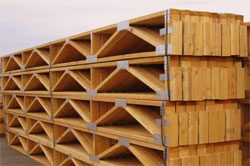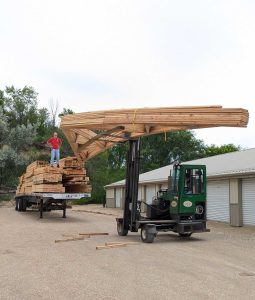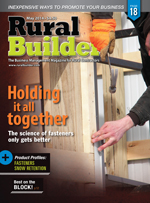When I was first in the metal connector plated wood truss industry back in 1977, my employers – Dutch Andres and Tom Vincent at Spokane Truss, had just invested in a machine which would fabricate what would be called a 4×2 floor truss.
These trusses revolutionized the way floors could be constructed – freeing up areas below them from the need for load bearing walls and columns in all of the most inconvenient places!
Rick Ochs is new to the inside team at Hansen Pole Buildings, and earlier this week, he posed a question:
“Hey Mike,
No rush… I have been viewing tutorials from WTCA (Wood Truss Council of America) on trusses and structural building components. I was wondering why we don’t spec floor trusses instead of the traditional 2×10 with hangers. Cost I presume.
Thanks!”
Floor trusses will be significantly more expensive.
Let’s say you have a 2×10 at .6285m (current price at The Home Depot®) so a 12′ would be $12.57.
(“m” happens to be lumber people’s secret code for 1000 board feet)
If they were even 16″ o.c., you are talking 0.79 per square foot for the cost of joists.
Floor trusses are going to run around $4.40 per lineal foot, spaced 2′ on center, this makes the cost per square foot for the joists at $2.20.
For a floor span of over 24′ trusses are certainly the way to go.
To which Rick responded:
“I’m thinking it would take a little more math on the builder/customer part to compare against labor cost savings of setting floor truss vs time required to set hangers, cut and nail joists.”
Personally, I have metal connector plated wood floor trusses in two of my personal buildings – in one case spanning 30 feet and the other 48 (yes a 48 foot clearspan floor).
Here are some of the benefits of using wood floor trusses:
- Larger sheathing attachment, with 2×3 or (usually) 2×4 nailing surface,
- Spacing up to 24” o.c. maximizes efficiency, decreasing installation time.
- Each unique truss is engineered to proper codes and loading.
- Speeds up mechanical installation (think heat ducts) with the open webbing thus saving dollars.
- Span longer distances than conventional lumber or I-joists.
- Special bearing, cantilever, and balcony details are easily built in.
- Less pilferage, it is unlikely a 20’ truss is going to walk off the jobsite.
- Faster jobsite build times, saving jobsite labor, construction loan interest, vandalism, and environmental damage.
Wood floor trusses can also be designed to limit the deflection and vibration, read more here:
https://www.hansenpolebuildings.com/2015/12/wood-floors-deflection-and-vibration/
In the global scope of life, having a wood truss supported floor is a fairly economical upgrade, which is certainly something worth investigating.

 As Mike the Pole Barn Guru, I’m highly flattered to have been selected to author a chapter in Volume II of this book series. Obviously I’ve written a couple or three (nearly 800) blog articles. I’ve also been a contributing writer for publications such as Structural Building Components and Rural Builder, however this will be my first foray into being published in a book. Pretty exciting stuff for me.
As Mike the Pole Barn Guru, I’m highly flattered to have been selected to author a chapter in Volume II of this book series. Obviously I’ve written a couple or three (nearly 800) blog articles. I’ve also been a contributing writer for publications such as Structural Building Components and Rural Builder, however this will be my first foray into being published in a book. Pretty exciting stuff for me. For those of us in the post frame (pole building) industry, Rural Builder magazine is a must read. Published seven times a year – I always await receiving my Rural Builder in the mail with a degree of anticipation and excitement. I have probably not missed reading (and rereading) an issue in three decades.
For those of us in the post frame (pole building) industry, Rural Builder magazine is a must read. Published seven times a year – I always await receiving my Rural Builder in the mail with a degree of anticipation and excitement. I have probably not missed reading (and rereading) an issue in three decades.





